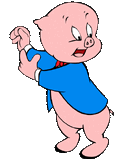|
Stamped on February 2017. This article or section needs additional citations for verification. Please add reliable citations to help verify the article's content.
Do not use Wikipedia or any other wikis as a source. Unsourced info can be questioned and may be removed without notice. Do not remove this template until all conditions have been met. |
Porky Pig is an animated cartoon character in the Warner Bros. Looney Tunes and Merrie Melodies series of animated cartoons. He was the first character created by the studio to draw audiences based on his star power, and the animators (particularly Bob Clampett) created many critically acclaimed shorts using the sentient porcine.
Even after he was supplanted by later characters, Porky continued to be popular with audiences and, more importantly, the Warners directors, who recasted him in numerous everyman and sidekick roles. He is known for his signature line at the end of each short, "Th-Th-Th-That's All Folks!" but in fact, this slogan has been used by both Bosko and Buddy and even Beans at the end of every Looney Tunes cartoon. In contrast, the Merrie Melodies series used the slogan: So Long, Folks! until the late 1930s when it was replaced with the same one used on the Looney Tunes series.
Early films
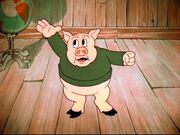
Porky as he first appeared in "I Haven't Got a Hat"
The character was created by Freleng and developed/animated by Bob Clampett in the short "I Haven't Got a Hat" (First released on March 2, 1935), directed by Friz Freleng. Studio head Leon Schlesinger suggested that Freleng do a cartoon version of the popular Our Gang films. Porky only has a minor role in the film, but the fat little stuttering pig easily stole the show. Porky's name came from two brothers who were childhood classmates of Freleng's, nicknamed "Porky" and "Piggy".[1]
Since Hugh Harman and Rudolf Ising had left the studio in 1933, taking the studio's star character Bosko with them, Looney Tunes had been kept afloat by cartoons featuring the bland Buddy. Porky's introduction ushered Buddy out the door and pointed to things to come. Unlike previous Looney Tunes characters before him such as Bosko or Buddy, Porky was a distinctive character.
Tex Avery was hired to the studio in 1936, and his film "Gold Diggers of '49" reused much of the cast from "I Haven't Got a Hat", albeit in wildly different roles. Porky transitioned from a shy little boy to an immensely fat adult. Though he was still in a supporting role, Porky got most of the laughs. The directors realized they had a star on their hands.
Actually, Friz Freleng claims to have given Porky Pig the stutter. "I used the stuttering because I thought it would give him (Porky Pig) something different, some character," Freleng told Joe Adamson, an interviewer.[2] Freleng and the staff hired Joe Dougherty to play Porky because he actually had a stuttering problem. However, production costs became too high when Dougherty could not control his stutter and many more takes would have to be made. Warner Bros. let him go in 1937 and the versatile Mel Blanc, who just came into a contract with Leon Schlesinger, won the audition for the character in 1937, beginning his long career with the studio. Blanc continued the stutter, however, it was reduced for a comic effect.[3]
Clampett's Porky
Porky starred in dozens of films in the late 1930s. The directors still didn't have a grasp on the character, however; his appearance, age, and personality all varied from picture to picture. Bob Clampett would finally pin Porky down, making him cuter, smarter, and less of a stutterer. Clampett's Porky was an innocent traveler, taking in the wonders of the world—and in Clampett's universe, the world is a very weird place indeed.[4] This principle is perhaps best demonstrated in Porky in Wackyland (1938), a film that sends
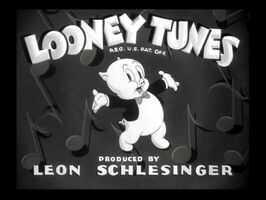
Bob Clampett's version of Porky Pig in the intro of a Looney Tunes cartoon.
Porky on a quest to find the last of the Dodo Birds. This cartoon was selected for preservation by the National Film Registry in 2000.[5]
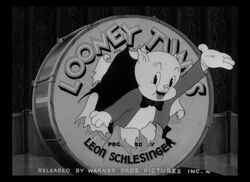
Porky as sidekick
Porky's post at the pinnacle of the Warners' pantheon was short-lived, however. In 1937, Avery pitted Porky against a plucky black duck who would soon be christened Daffy and would become the studio's biggest star (until replaced himself by Bugs Bunny). In fact, Friz Freleng would satirize this very phenomenon when he directed '"You Ought to Be in Pictures" (1940). The film features up-and-comer Daffy convincing Porky to quit his job at Warner Bros. to find better-paying work elsewhere. In turn, Porky convinces studio head Leon Schlesinger to release him from his contract. After a highly unsuccessful foray into the real world, Porky returns happily to the studio that created him.

Redrawn Porky Ending
Porky always remained a sentimental favorite of the Warner directors. His mild-mannered nature and shy demeanor made him the perfect straight man for zanier characters such as Daffy Duck. He still starred in a few solo cartoons, as well, such as Frank Tashlin's "Swooner Crooner" (1944).
Other cartoons dumbed Porky down and cast him as a duck hunter after Daffy, largely paralleling the Elmer Fudd/Bugs Bunny pairings.
Chuck Jones perfected the Porky-as-straightman scenarios, pairing the pig with Daffy Duck in a series of film parodies such as "Drip-Along Daffy" (1951), "Deduce, You Say" (1956), and "Robin Hood Daffy" (1958).
Jones also paired Porky with Sylvester in a series of cartoons in the late 1940s and early 1950s, in which Porky plays the curmudgeonly owner of the cat and remains clueless that Sylvester is constantly saving him from homicidal mice, space aliens, and other threats.
Porky, of course, also kept his trademark line, "Th'-th'-th'-th'-th'-th'-that's All, Folks!" that became the signoff for many Looney Tunes cartoons. Prior to Porky's arrival, the line had often been spoken (without the stutter) by a cartoon court jester. Sometimes Bugs Bunny would also do the honors; in those closing segments, Bugs would munch on a carrot and say, "And dat's de end!" But Porky's closing line was so memorable that Mel Blanc's will provided for it to be carved on his own headstone during his death in 1989.
Later years
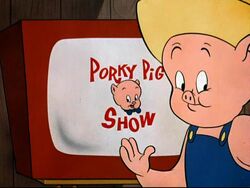
Porky Pig, as seen in the opening title sequence of The Porky Pig Show
As did the rest of his Looney Tunes co-stars, Porky enjoyed regular rotation in television syndication beginning in the 1960s. In 1964, Porky got his own Saturday morning cartoon, The Porky Pig Show which ran until 1967. In 1971, he would star in another show, Porky Pig and Friends.[6] Both of these programs were collections of old theatrical shorts not seen on the Bugs Bunny / Road Runner anthologies. Another such collection was the 1986 film, Porky Pig in Hollywood, which ran in art and college theaters.[7]
In the 1990s animated series Tiny Toon Adventures, Porky appears as the mentor of Hamton J. Pig.
Porky Pig also appears as the Eager Young Space Cadet in the animated television series Duck Dodgers.
In 1991, the National Stuttering Project (NSP) of San Francisco picketed Warner Bros. demanding that they stop "belittling" stutterers and use Porky Pig as an advocate for child stutterers. The studio refused the NSP but eventually agreed to grant $12,000 to the Stuttering Foundation of America for a 1994 conference. After continued pressure from NSP member Ira Zimmerman, Warner Bros. released a series of public service announcement posters featuring Warners characters, including Porky himself, speaking out against bullying. Despite these recent protests, Porky continues to feature in new Warner Bros. animation to this day. An alternate school of thought is that the morally upright and ever-optimistic Porky provides a positive role model for stutterers.[8]
Porky appears in the movie Space Jam (1996) and collaborates with Bugs Bunny and the rest of the other major Looney Tunes characters in challenging the Nerdlucks to a basketball game. He tries to get Michael Jordan's autograph when the basketball star is first recruited to join the team and later plays for the Toon Squad in the game itself, scoring one basket. In the post-credits scene, Porky tries to end the movie with his famous line but is prevented through the combined efforts of Bugs Bunny, Daffy Duck, and the Nerdlucks.
In the movie Looney Tunes: Back In Action, Porky makes a cameo appearance alongside Speedy Gonzales, where they both lament their politically incorrect status. At the end of the movie, he also fails to deliver his ending quip before the studio closes, and just tells the audience to go home.
Porky is the star of the Super NES video game Porky Pig's Haunted Holiday.
Porky also has a cameo at the end of Who Framed Roger Rabbit? (1988), where, paired with Disney's Tinkerbell, has the duty of closing the movie with his famous "That's All Folks!" line.
A baby version of Porky appears in Baby Looney Tunes' musical numbers.
Porky has a descendant in Loonatics Unleashed (2005–2007) named Pinkster Pig (who was also voiced by Bob Bergen) who started off as an old ally of Danger Duck (Daffy Duck's descendent), but became a villain when he was adopted by Stoney and Bugsy (descendants of Rocky and Mugsy).
Porky also appears as a regular in Cartoon Network's animated sitcom The Looney Tunes Show (2011–2014), voiced here by Bob Bergen. He is still friends with Daffy Duck and often sucked into Daffy's schemes. Porky is also Bugs' nervous, fall-guy buddy, similar to their relationship in classic comic books. It is also revealed in the show that in his high school years he was a jock who bullied Daffy. Porky also appears in the direct-to-video movie Looney Tunes: Rabbits Run (2015).
Porky Pig appears in New Looney Tunes (formerly Wabbit) voiced again by Bob Bergen. He is shown to be an immensely fat pig, similar to his first few appearances in the mid-1930s. Porky was first mentioned in "Dust Bugster" where he told Bugs about a TV series whose name was not mentioned that led to Bugs binge-watching it. He is typically paired with Bugs, Daffy or Gabby.
Blooper
A short black-and-white blooper was made in 1938 as part of a Warner Bros. blooper reel. It was shown on the

Porky Pig Blooper
Warner Bros. 50th Anniversary TV show.[9] Porky is shown doing some carpentry work, pounding nails when he smacks his thumb with the hammer. Grimacing in pain, he cries, "Oh, son of a bi-bi-, son of a bi-bi-, son of a bi-bi-bi-... gun!" He then turns to the camera and says "Ha-ha-ha! You thought I was gonna say 's-s-son of a bitch', didn't ya?!"[10]
This short, so-called "blooper" can also be found on the Looney Tunes Golden Collection: Volume 4 of 2006, under the title Porky's Breakdowns (with several versions of the clip, making it look like a true "blooper"), and on an Each Dawn I Die DVD box set, also released in 2006.
Voice Actors
- Joe Dougherty: 1935 - 1937
- Mel Blanc: 1937 - 1989
- Bob Bergen: 1990 – present
- Noel Blanc: Happy Birthday, Bugs!: 50 Looney Years, Tiny Toon Adventures
- Jeff Bergman: The 1st 13th Annual Fancy Anvil Awards Show Program Special, Gremlins 2: The New Batch, The Earth Day Special, Cartoon Network Bloopers, Bugs Bunny's Overtures to Disaster, Invasion of the Bunny Snatchers, Porky and Daffy in the William Tell Overture
- Billy West: Cock-A-Doodle-Duel, "My Generation G...G... Gap", "Daffy Contractor"
- Rob Paulsen: Tiny Toon Adventures, Animaniacs
- Greg Burson: Tiny Toon Adventures, Animaniacs
- Eric Goldberg - "Superior Duck"
Filmography
- Main article: List of Porky Pig cartoons
Notes
In 1936's Plane Dippy, Porky gives his name as Porky Cornelius Washington Otis Lincoln Abner Aloysius Casper Jefferson Philbert Horatius Narcissus Pig.[11]
Gallery
- Main article: Porky Pig/Gallery
See also
References
- ↑ Beck, Jerry. Audio commentary for "I Haven't Got a Hat" on the Warner Brothers D.V.D. set Looney Tunes Golden Collection, Volume 3. (2005) citing Freleng's autobiography.
- ↑ Hollywood Cartoons: American Animation in its Golden Age p.329
- ↑ Barrier, Michael (1999). Hollywood Cartoons: American Animation in Its Golden Age. Oxford: Oxford University Press. ISBN 978-0-19-516729-0.
- ↑ Maltin, Leonard. Of Mice and Magic: A History of American Animated Cartoons (Revised Edition), 1987, Plume ISBN 978-0-452-25993-5 (Softcover) ISBN 978-0-613-64753-3 (Hardcover).
- ↑ List of National Film Registry (1988-2003).
- ↑ imdb.com - The Porky Pig Show.
- ↑ Maslin, Janet. "SCREEN: PORKY PIG IN HOLLYWOOD", The New York Times, November 28, 1986. Retrieved on November 20, 2011.
- ↑ https://books.google.com/books?id=1uXTDQAAQBAJ&pg=PT345&lpg=PT345&dq=national+stuttering+association+warner+bros&source=bl&ots=guz5LhwvPl&sig=51x7hW7QZKM0JeDXnhTfYvqlwx4&hl=en&sa=X&ved=0ahUKEwiwu5f4t-3TAhUJzWMKHVRTBV0Q6AEIPTAC#v=onepage&q=national%20stuttering%20association%20warner%20bros&f=false
- ↑ Toon Zone - LT & MM: The Early Years - Other Videos
- ↑ Porky Pig "blooper"
- ↑ [1]http://likelylooneymostlymerrie.blogspot.com/2012/03/121-plane-dippy-1936.html?showComment=1330849570438#c2022256339305867202



